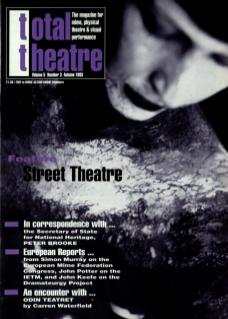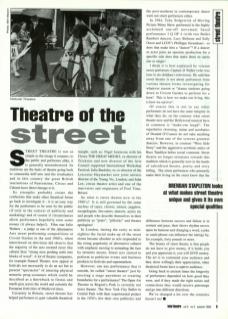Street theatre is not as simple as the image it conjures, to the public and performer alike; it is generally misunderstood. Its traditions are the basis of theatre going back to commedia dell'arte and the troubadors, and in this country the great British institutions of Pantomime, Circus and Cabaret have direct lineage to it.
Its strengths probably create the confusions that make other theatrical forms go back to investigate it – it is an easy way for the performers to be seen by the public (if only in the context of publicity and marketing) and of course if circumstances allow performers hopefully earn some money (it always helps!). Film star Julie Walters – a judge at one of the Alternative Arts street performing competitions at Covent Garden in the mid 1980s, when interviewed on television did observe that the majority of the acts seemed more like cabaret than ‘strong men pushing nails into blocks of wood’. A lot of theatre companies, for example Natural Theatre, now appear at festivals not necessarily to do an act but to present ‘spectacles’ of amazing physical mimetic prop-costumes which could be described as a throwback to fiestas and mardi-gras across the world and certainly the European festivities of Medieval times.
Certainly in Britain, street theatre has helped performers to gain valuable theatrical insight, such as: Nigel Jamieson with his Clown The Great Medici, ex-director of Trickster and now director of the Arts Council supported International Workshop Festival; Julia Bardsley, ex co-director of the Leicester Haymarket, now joint artistic director of the Young Vic, London; and John Lee, circus theatre artist and one of the innovators and originators of Fool Time, Bristol.
So what is street theatre now in the 1990s? It is still governed by the same nucleus of types, clowns, mimes, jugglers, escapologists, fire-eaters, dancers, actors, etc, and people who describe themselves in their publicity as ‘prats’, ‘pillocks’ and theatre apologists!
In London, during the early to mid eighties the facial make-up of the street clown became obsolete as acts responded to the rising popularity of alternative cabaret with emphasis moving to animating the face by mimetic means. Street acts started to perform to publicise events and business products in festivals and supermarkets.
However, can any performance that is outside, be called ‘street theatre’ just by erecting a stage anywhere or creating boundaries for a performance? The Open Air Theatre in Regent's Park is certainly not street theatre. The New York City Ballet in Central Park with their experimental project in the 1970s (for their own publicity) and the post-moderns in contemporary dance were not street performers either.
In 1984, Toby Sedgwick of Moving Picture Mime Show performed in the highly acclaimed one-off movement based performance IQ of 4 (with two Ballet Rambert dancers, Lucy Bethune and Sally Owen, and LCDT's Philippe Giraudeau) – so does that make him a ‘dancer’? If a dancer or actor joins an operatic production for a specific role does that make them an opera star or singer!
I think it is best explained by veteran street performer, Captain JJ Waller (who was later to do children's television). He said that street theatre is not about performers from various theatre forms investigating for whatever reason or ‘drama students going down to Covent Garden to perform for a hoot! This is how we make our living, this is how we survive.’
Of course this is not to say other performers do not have the same integrity in what they do, on the contrary what street theatre now and the Hollywood musical have in common is ‘make-em laugh’. The superlative clowning, mime and acrobatics of Donald O'Connor do not take anything away from one of the screens greatest dancers. However, in contrast ‘West Side Story’ and the aggressive acrobatic antics of Russ Tamblyn belies social comment. Street theatre no longer orientates towards this tradition which is generally now in the hands of subsidised theatre, poetry and storytelling. The street performers who primarily make their living on the street know that the difference between success and failure is in content and pace: their show’s rhythm moves upon its humour and changing a word, a joke or catch-phrase can influence the takings by, for example, forty pounds or more.
The beauty of street theatre is that people do not have to give money; if it holds you and you appreciate it, you will give money. The art is to command your audience and they show willingly their appreciation; other theatrical forms have a captive audience.
Going back to ancient times the longevity of performers depended on how good they were, and if they made the right noises and connections they would receive patronage and go into different directions.
We've changed a lot over the centuries haven't we!

